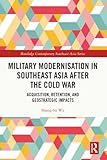Military Modernisation in Southeast Asia after the Cold Wars : acquisition, retention, and geostrategic impacts / Shang-Su Wu.
Material type: TextSeries: Routledge contemporary Southeast Asia seriesPublication details: London and New York: Routledge, Taylor & Francis, 2024.Edition: First editionDescription: 316 Pages; 24 cmISBN:
TextSeries: Routledge contemporary Southeast Asia seriesPublication details: London and New York: Routledge, Taylor & Francis, 2024.Edition: First editionDescription: 316 Pages; 24 cmISBN: - 9781032471372
- 355/.033259 23/eng/20231201
- JZ6009 .S938 W8 2024
| Item type | Current library | Collection | Call number | Copy number | Status | Notes | Barcode | |
|---|---|---|---|---|---|---|---|---|
 Books
Books
|
Rabdan Academy General Stacks | General Collection | JZ6009 .S938 W8 2024 (Browse shelf(Opens below)) | C. 1 | Available | AED 414.75 | 23237 | |
 Books
Books
|
Rabdan Academy General Stacks | General Collection | JZ6009 .S938 W8 2024 (Browse shelf(Opens below)) | C. 2 | Available | AED 414.75 | 23238 |
Introduction -- Indonesia -- Malaysia -- Myanmar -- the Philippines -- Singapore -- Thailand -- Vietnam -- Brunei, Cambodia, and Laos -- Conclusion.
"Southeast Asian countries represent a wide range of approaches to military modernisation due to their great diversity in politics, economies, geography, and other factors. Bounded by the Pacific and Indian Oceans and located between China and India is the setting for the geostrategic impacts of military modernisation in Southeast Asian countries. Differing from previous research focused on military acquisition, this book additionally covers retention of assets and carefully examines the ageing issues that affects readiness and capabilities. In doing so, it provides a comprehensive view of military modernisation. This book also compares each country's situation in the region in terms of military strength and security challenges to elaborate on the geostrategic impacts of military modernisation. The ten cases of military modernisation in the post-Cold War context provide rich content for readers to explore the evolution of military modernisation in developing countries after 1991. This book sheds light on security studies of Southeast Asia and is a useful resource for academic researchers, policy-makers, and defence practitioners"--
There are no comments on this title.
